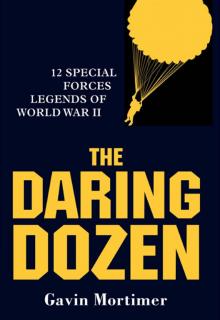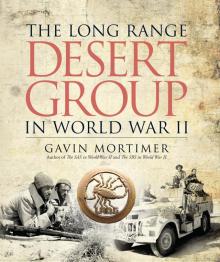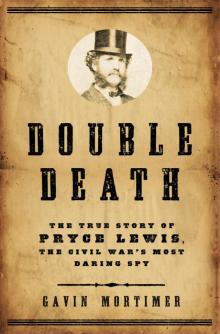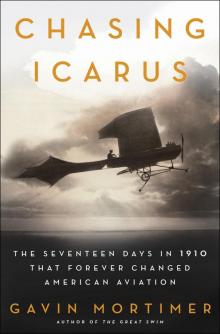- Home
- Gavin Mortimer
Double Death Page 11
Double Death Read online
Page 11
The next day, Monday, July 22, Lewis enjoyed the freedom of the camp and made several acquaintances among the officers. At one moment he doffed his cap and stood in silence as “the remains of Captain Allen of Cincinnati, who had been killed in the skirmish at Scary on the 17th were brought into camp to be forwarded to his family.” Throughout the day Lewis was summoned from time to time to Cox’s headquarters to answer a question or clarify a point relating to his mission. As the general pondered his next move, aware that his orders from McClellan were to remain where he was, a steady stream of vessels arrived from the west bringing men, munitions and wagons.
Lewis learned on Tuesday that Cox had decided to act on his information. A large patrol had already departed to reconnoiter east toward Scary Creek, and a second patrol was about to set off by boat. Lewis asked permission to accompany the troops. Cox acceded to the request, and Lewis squeezed onto the vessel among the Union soldiers.
For several miles they ascended the river without incident. Then up ahead they saw smoke rising from the trees. The vessel stopped and soldiers disembarked, moving cautiously toward the smoke. Lewis remained on board, smoking, and passing the time of day with two army surgeons. Presently, a detail of Union soldiers appeared prodding a captured rebel at the end of their bayonets. Lewis recognized the prisoner’s dark green uniform as that of Colonel Patton’s regiment. The man refused to speak, but his guards explained that the Confederates were in retreat and were burning bridges as they went. A short while later a messenger arrived from the foot patrol. He requested a surgeon because “the commander of the rebel forces had been captured and was at his headquarters badly wounded.”
Both surgeons stepped ashore and asked Lewis if he wished to accompany them. He accepted, and they set off with the messenger and a military escort toward the wounded rebel officer. They reached a road that Lewis recognized as the James River and Kanawha Turnpike. It seemed an eternity since he and Bridgeman had come this way in a carriage. They passed some Union soldiers sheltering from the sun under a tree, and soon the messenger was explaining that the captured rebel officer was around the next bend. Lewis turned the corner but he already knew what he would find: the farmhouse in which he had been entertained by Colonel Patton.
On the grass in front of the farmhouse scores of Union soldiers were warming themselves in the sun while two sentries stood on the veranda. Lewis knew it was Patton lying wounded inside; his intuition told him so, but he had no wish to meet a man “whose gentlemanly confidence I had so completely won.” He excused himself from going inside the house, explaining to the surgeons that the sight of blood made him queasy.
When Lewis met the surgeons back on the boat they confirmed that the wounded officer had indeed been Patton. Shot in the shoulder during the Scary Creek fight, he was recovering at his headquarters when the Union troops attacked. Whether the colonel had been abandoned by his fleeing men, or whether he was too ill to be moved, the surgeons didn’t say. But he was now a prisoner of the Union army.
Later that evening Lewis was summoned to Cox’s headquarters. He “found him on the upper deck pacing up and down, apparently in deep study.” Cox told Lewis he was confronted by a dilemma: the good news was that the patrols had returned triumphant, not only with a captured Confederate colonel but with reports indicating the rebels were not the formidable force he had been led to believe. Lewis agreed that the enemy was there for the taking, so why the delay?
The bad news was contained on a slip of paper Cox handed Lewis. It was a message he’d just received from Colonel Guthrie (commanding officer of the First Kentucky Regiment) that gave Wise’s troop strength as somewhere in the region of sixty thousand men. Lewis gave a laugh of disbelief and dismissed it as a falsehood, spread either by Wise’s spies or by genuine Unionists who had been duped by the rebels. Lewis told Cox that such wild claims were not unusual in Kanawha County and that “ten miles from Charleston I heard that Wise had 20,000 men, and as I got further away in the mountains, his force was estimated at 50 and 60,000.” Cox went to the deck rail and stared at the dark water below. After a few seconds he turned and asked Lewis if he’d eaten. No, replied Lewis, he hadn’t. Cox told him to do so and return at eight o’clock. The spy did as instructed, and when he arrived at the general’s headquarters he found him “at a large round table with eight or ten officers.” Cox ordered Lewis to repeat his account of his trip through the Kanawha Valley, “the whole story, omit nothing.”
While Cox agonized over his next move, his rebel counterpart was in a similar state of flux. For the past week General Wise had been sending begging dispatches south. On July 17 he had implored Richmond to “re-enforce us with men, arms and ammunition”; on July 18 he pleaded for four twelve-pound howitzers so he could follow up the success at Scary Creek by attacking Cox’s main camp; on July 19, with no response to his earlier requests, a desperate Wise demanded the following: “double the number of officers we have … pay, forage for horses … two sixed rifles, two 12-pound howitzers, and allow us four small 4-pounders … by all means, then, hasten on re-enforcements, arms and ammunition.”
Wise knew the Northern net was tightening, and he wanted to make sure Richmond knew it too. He entrusted his dispatch of July 19 to Major C. B. Duffield, a doughty soldier who could be relied upon to deliver what Wise feared might be his epitaph. Wise closed the report by stating his predicament, explaining that Cox was at Pocotaligo Mouth. “He is now there, about three thousand, three hundred strong, awaiting re-enforcements. We are threatened by that number in the valley, by about one thousand five hundred from Ripley to Sissonville, and by forces from Weston, Glenville, and Sutton, via Summersville. If I go toward Point Pleasant they rush on Coal, on Two Mile, and the Elk and Gauley, and if I move out of the [Kanawha] valley in any direction with anything like an effective force, they rush in and rake the valley, and if I stand still they move from all sides and shut me in.”
When Wise turned in for the night at his headquarters on Tyler Mountain on Tuesday, July 23, he had received neither arms nor men. He hadn’t even taken delivery of more forage for his horses. Abandoned by the Confederate High Command, surrounded by Federal forces, Wise was certain an attack was imminent, but he had no clear idea from which direction it would come.
Having listened to Pryce Lewis, Cox and his officers decided to attack the next day, Wednesday, July 24. They burned the midnight oil, discussing what strategy to adopt. Wise’s position was five miles north of Charleston and approximately ten miles east of the Union camp. Cox knew that the Confederates had an accurate estimate of his army, but he was confident the rebels assumed he would launch his assault from the west, along the same route his two patrols had taken earlier that day. Cox studied the map of the Kanawha Valley and concluded that the best chance of surprising Wise was to march his men north, then wheel and strike his rear.
At dawn on July 24, as Lewis waited to catch a ride on the first steamer heading back up the Kanawha toward Cincinnati, the bulk of Cox’s army went to war. Leaving one regiment to guard the camp and steamboats, Cox marched his men north and then swung east. Just before sundown, as the smell of sizzling meat wafted through the wooded mountainside, Cox’s men attacked. It was a rout, reported the general, with Wise’s army reduced to “a panic-stricken force running off, leaving their camp in confusion, and their supper which they were cooking.”
The remnants of the rebel army fled south, through the former camp at Kanawha Two Mile, from where Wise had earlier predicted he could “whip the world,” and over the iron suspension bridge that spanned the Elk River. The fleeing men vandalized the bridge the best they could, severing cables and removing flooring, and then continued their pell-mell dash to Charleston.
Cox’s men pursued the rebels all the way, though the damaged suspension bridge cost them precious time. While Wise and his men piled into steamboats and headed east along the Kanawha toward Gauley Bridge, the Federal troops constructed a pontoon from the empty coal barges moored on the Elk, and cross
ed the river into Charleston. There to greet the invaders was Mayor Jacob Goshorn, dignified but terrified, mindful that Wise had warned him the “murdering Yankees” were close on his heels.
The Union general set up his headquarters in Charleston and on Friday, July 26, took off after Wise. For three days he marched his men southeast toward Gauley Bridge, expecting at any moment to be ambushed. But they reached the town without incident. Cox learned that the rebels had paused in Gauley Bridge just long enough to burn the 190-yard wooden covered bridge that carried the James River and Kanawha Turnpike across the Gauley River, and then pushed on to Lewisburg.
Cox gave up the chase at Gauley Bridge. The farther east he headed, the more he stretched his supply line, and why risk running into the rebels when he already had what he wanted: Charleston, Gauley Bridge and control of the Kanawha River. General McClellan was jubilant when he heard of Cox’s success; he ignored the fact that by pushing on to Gauley Bridge, Cox had disobeyed his order not to advance east beyond Charleston. That didn’t matter; what did was the defeat of Wise, coming as it did just three days after the Confederate victory at Bull Run.* But now he, General George McClellan, had restored the reputation of the Northern army.
Wise’s force reached Lewisburg on August 1. Not a man among them believed any more in the glory of war. The sixty-four miles from Gauley Bridge had been a living hell. Sickened by measles, weakened by hunger, drenched by thunderstorms, the survivors who staggered into Lewisburg were no longer soldiers; they were scarecrows bereft of equipment and respect. Wise overheard one of his men describing to a civilian what they had endured on the “retreat.” He came running over screaming: “Retreat! Never dare call it a ‘retreat’ again, sir. It was only a ‘retrograde’ movement.” The soldier no longer cared for military protocol; he was too exhausted. Looking up at his commanding officer with a wry smile, he replied, “I don’t know nothing about your retrogrades, general, but I do know we did some damn tall walking.”
Two days later Wisconsin’s Prescott Transcript reported that a dispatch had been received from General Cox in which he described how the “rapid pursuit of Wise’s forces resulted in the capture of 1,000 stand of arms and a large amount of gunpowder left behind by the enemy … there was no chance for a fight, for the rebels retreated faster than retreat could be made.” As for the number of Confederate troops encountered by the Union troops, the Prescott Transcript gave the figure as around “5000 or 6000,” just as Lewis had forecast.*
*Wise judged that his force was too small and too poorly equipped to attack the Federal troops. He sent a request that General Robert Garnett, in charge of rebel troops at Rich Mountain, reinforce him, but it was too late—the Union troops had seized Rich Mountain and routed Garnett’s troops. Wise withdrew to Tyler Mountain, five miles north of Charleston and approximately three miles east of Colonel Patton’s camp.
*Bull Run was the Union name for the battle; to the Confederates it was Manassas, so called after the town that served as their camp.
*Wise learned in Lewisburg that the reinforcements for which he had begged were being assembled in Monterey, on the eastern side of the Allegheny Mountains. While he was recalled to Richmond, General Lee went north to take charge of the twenty-thousand-strong rebel army, and throughout late August and September there were sporadic clashes in the Allegheny passes. But the rebels were unable to make the decisive breakthrough, and in October Lee left Virginia for South Carolina. In the same month the people of western Virginia voted to establish a separate state, and in May 1862 the creation of West Virginia was officially sanctioned.
C H A P T E R E L E V E N
“That Is Tim Webster”
IT WAS LATE AUGUST 1861, and Pryce Lewis and Sam Bridgeman were reunited, though this time there was no need for disguises. The pair were at Baltimore’s Miller’s Hotel, on the corner of German and Pacer streets, awaiting instructions from Allan Pinkerton. After the success of their mission to Charleston, the pair were Pinkerton’s new golden boys. Or, at least, Lewis was. When he’d returned to Cincinnati from his trip to General Cox’s camp, Lewis learned that Bridgeman was no longer an employee of the Pinkerton detective agency. He’d been “discharged for celebrating our safe return too hilariously.” Lewis went to see Pinkerton and told him that, yes, Sam liked a drink now and again, but he’d done a good job as his coachman and he deserved a second chance. Pinkerton acquiesced but emphasized Bridgeman was on his final warning.
Although Baltimore belonged to the Union in August 1861, it still seethed with discontent. The plot to assassinate President Lincoln might have been nothing more than a Pinkerton concoction, but what had happened on April 19 was anything but. On that day the Sixth Massachusetts Regiment had marched through the city, the first Northern troops to do so, and their presence wasn’t appreciated. A furious mob attacked the soldiers as they headed to the train station, and in the ensuing chaos four troops and twelve civilians were killed. The following month the situation remained tense, as the correspondent of the New York Herald discovered when he arrived at Baltimore’s Camden Station: “Half-drunken loafers swarmed therein,” he reported. “They carried costly daggers, revolvers of the latest fashion, and knives of glittering polish, while as they swaggered through the long passage, they d-d the Union, gave maudlin cheers for Maryland, and boasted of their future prowess … at every corner [of the city], in the middle of the streets, and around the hotel doorways, stood and shouted always the same brutal swarm. No life is safe there unless its possessor will say their says, no person is sacred there unless its possessor will say their says, no person is sacred there unless its spirit is against the Federal Union, and no property will long be inviolate whose holder does not loud and long proclaim his devotions to Southern interests and his seal for the Southern cause.”
Secessionists burned bridges and felled telegraph poles, while the city’s legislature censured the Federal government but quailed at open rebellion. Governor Thomas Hicks described Baltimore’s position as one of neutrality, so more Union troops came to the city to ensure it stayed that way. Nevertheless the secessionists continued to foment sedition, particularly after the victory at Bull Run, a triumph that emboldened the city’s Confederate-leaning politicians to the extent that they publicly condemned Lincoln as a tyrant.
Pinkerton was asked to find out what he could about the secessionists in Baltimore, so he sent Lewis and Bridgeman there. They had no precise objectives; they were to observe and report. Lewis’s favorite observation post was the veranda of Miller’s Hotel. There they ordered drinks from a bartender named John Earl, a known secessionist. Lewis was taking in the view from the veranda one afternoon when “Bridgeman directed my attention to a gentlemanly-looking, stalwart passer-by, who was accompanied by a lady.”
“That,” said Bridgeman, leaning across to whisper in Lewis’s ear, “is Tim Webster.”
Allan Pinkerton described Tim Webster in 1861 as “a tall, broad-shouldered, good-looking man of about forty years of age. In height he was about five feet ten inches; his brown hair, which was brushed carelessly back from a broad, high forehead, surmounted a face of a character to at once attract attention.”
There was a beard as well, precise and modest, a reflection of his personality. Nothing about Timothy Webster was ostentatious; after all, he was descended from that most stolid of stock, the English yeoman.
Timothy Webster Senior had been one of the Duke of Wellington’s men during the Napoleonic Wars of half a century earlier, and once France had been crushed he returned to being a tinsmith, the occupation of his father and the trade to which he himself had been apprenticed before he’d left to be a soldier. Then he married his childhood sweetheart, Frances, and they moved from Leicester, in central England, to the county of Sussex on the southern coast in order to find work.
Timothy and Frances settled in the village of Newhaven and started a family: two healthy daughters named Mary and Maria, and at the end of 1819 their first son, Samuel, was born. Three years
later, on March 12, 1822, Frances Webster gave birth to another boy. This one they named after his father.
When Timothy was two, Reverend T. W. Horsfield visited Newhaven on a research trip for a book he was writing about the region. When the book was published the literate among Newhaven’s 929 inhabitants appreciated Horsfield’s description of their town: “The residents of Newhaven are chiefly engaged in maritime pursuits,” he explained. “There are, however, two extensive breweries and the place is noted for the excellence of its beer. There are four comfortable inns, and within the last twenty years the number of houses built is estimated at forty. The town is extremely neat and clean. Over the [river] Ouse is a handsome drawbridge, which was erected some years ago by an act of parliament in lieu of an ancient ferry.”
The reverend neglected to describe Newhaven’s centuries-old harbor (the reason why such a small town required a quartet of inns) from which a ferry sailed twice a week to France. Trading vessels also made frequent calls to Newhaven, and several ships a week arrived to transport boulders to the pottery districts of England. The boulders were collected from the Sussex countryside by the county’s poor and heaved down to the harbor. In 1823 the townsfolk of Newhaven amassed five and a half thousand tons of boulders.
For young boys too weak to help harvest boulders, Newhaven was a rural idyll in the 1820s. They might have scrambled up the hill behind the church of St. Michael (where Tim Webster had been baptized) to look out over the English Channel for the arrival of the ferry from France. And while they waited for the sails to appear, the young boys might have dug into the hillside searching for relics from the region’s previous inhabitants: a Stone Age flint, an Iron Age arrowhead or a Roman vase.
In the harbor they might have helped the fishermen unload the day’s catch: brill and sole and plaice. They might have pranced behind the hawkers who came to sell their wares, imitating their cries of “Taters O!” and “Damsons O!” and in the summer they might have dived from the wooden drawbridge into the river Ouse or swum in the cold waters of the Channel.

 The Daring Dozen
The Daring Dozen The Long Range Desert Group in World War II
The Long Range Desert Group in World War II Double Death
Double Death Chasing Icarus
Chasing Icarus